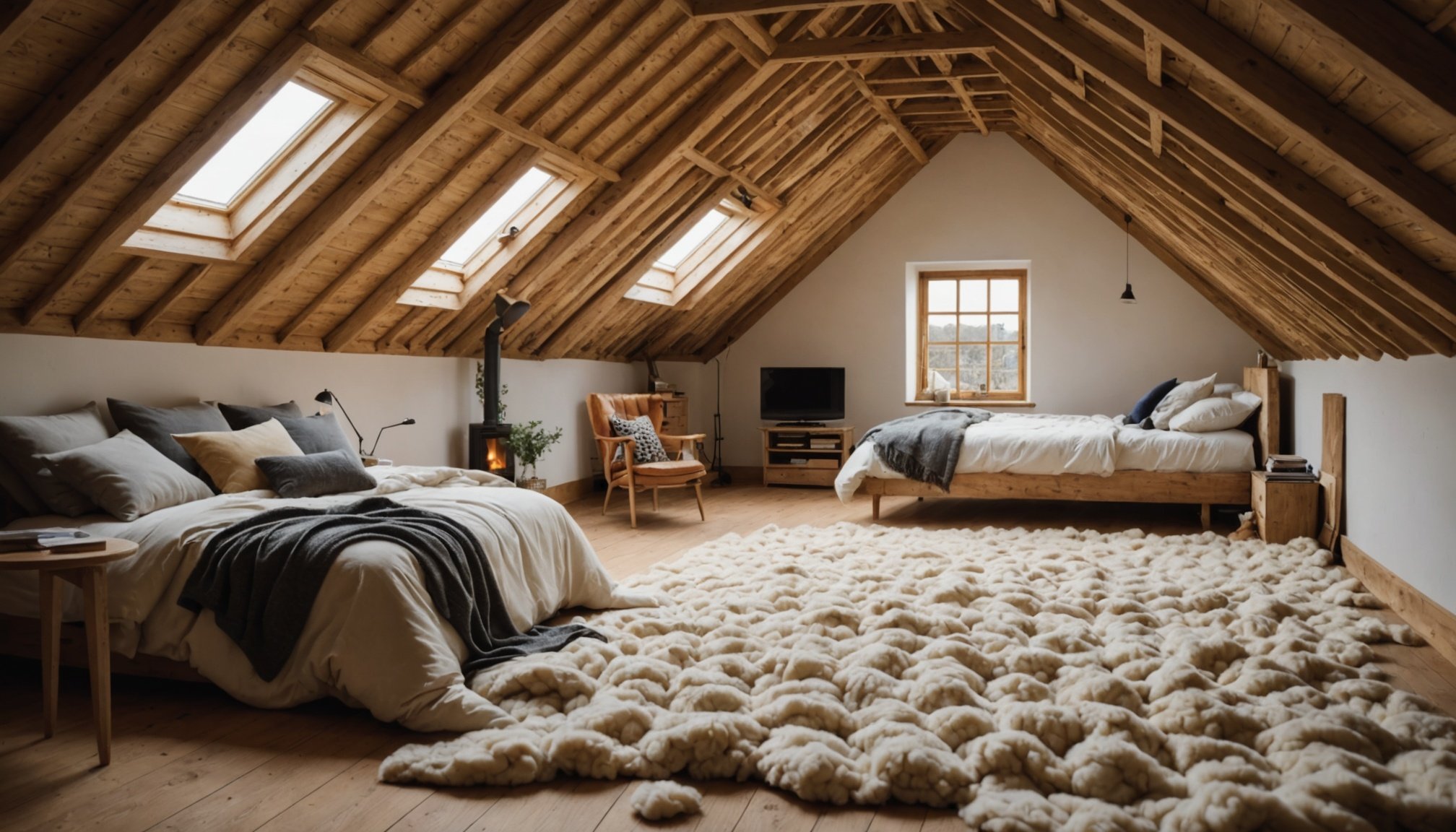Revamp Your Upgraded Loft: The Ultimate Guide to Eco-Friendly Wool Insulation
Why Choose Eco-Friendly Wool Insulation for Your Loft?
When it comes to insulating your loft, the choices can be overwhelming, especially if you’re looking for an option that is both effective and environmentally friendly. One of the best and most sustainable choices you can make is to use eco-friendly wool insulation. Here’s why:
Wool insulation, particularly sheep wool, has a significantly lower environmental impact compared to its synthetic counterparts. It is a natural, renewable, and biodegradable material that offers excellent thermal performance without the ecological drawbacks of synthetic materials[3].
In parallel : Transform your workout: eco-conscious fitness equipment that powers a greener gym
Benefits of Wool Insulation for Your Loft
Energy Efficiency and Cost Savings
Insulating your loft with wool can significantly reduce heat loss, which is crucial since up to a quarter of the heat produced in your home can escape through a poorly insulated loft and roof. This not only increases your energy bills but also contributes to a larger carbon footprint. By using wool insulation, you can save around £270 per year on your energy bills, with a payback period of just three years[5].
Environmental Impact
Sheep wool insulation is sourced from natural resources and has a minimal impact on the environment. Unlike synthetic materials, wool does not contribute to greenhouse gas emissions during its production process. Additionally, wool insulation can last for up to 40 years, making it a long-term solution for your home’s energy efficiency needs[5].
Also read : Unveiling green approaches for effective mosquito control in your garden ecosystem
Health and Comfort
Wool insulation is also beneficial for indoor air quality. It has natural moisture-regulating properties that help maintain a healthy indoor environment by absorbing and releasing moisture without compromising its insulating performance. This makes it an excellent choice for homes where occupants may suffer from allergies or respiratory issues[3].
Types of Wool Insulation
Sheep Wool Insulation
Sheep wool is one of the most popular and effective types of natural insulation. Here are some key points to consider:
- Thermal Performance: Sheep wool provides excellent thermal insulation, keeping your home warm in the winter and cool in the summer.
- Moisture Regulation: It naturally regulates moisture levels, preventing damp and mold growth.
- Fire Resistance: Wool is inherently fire-resistant, adding an extra layer of safety to your home.
- Sustainability: It is a renewable resource with minimal environmental impact[3].
Other Natural Insulation Materials
While sheep wool is a top choice, other natural materials can also be considered:
- Mineral Wool: Made from rock or glass particles, mineral wool is another eco-friendly option that offers good thermal performance and is resistant to fire.
- Wood Fibre Insulation: This is made from wood residues and offers good thermal insulation along with being eco-friendly.
- Cellulose Insulation: Made from recycled paper products, cellulose insulation is a cost-effective and eco-friendly option[5].
How to Insulate Your Loft with Wool
Preparation and Safety
Before you start insulating your loft, ensure it is safe and accessible. Here are some steps to follow:
- Clear the Space: Remove any stored items and debris from the loft.
- Check for Damp: Ensure there are no signs of damp or mold. Address any issues before proceeding.
- Wear Protective Gear: Use gloves, a mask, and safety glasses to protect yourself from insulation materials.
Installation Methods
There are two primary methods for installing wool insulation in your loft:
Blanket Insulation
- Materials: Use batts or rolls of sheep wool insulation.
- Installation: Lay the insulation between and over the floor joists or roof rafters.
- Coverage: Ensure the entire loft floor is covered, with a minimum depth of 270mm as per regulations[5].
Blown-In Insulation
- Materials: Use loose-fill wool insulation.
- Installation: Professional installers use special applicator hoses to blow the insulation into the loft space, ensuring all areas are covered.
- Coverage: This method is ideal for hard-to-access areas and ensures comprehensive coverage[5].
Cost and Financial Incentives
Cost Comparison
Here is a comparison of the costs associated with different types of loft insulation materials:
| Insulation Type | Cost per Square Meter |
|---|---|
| Spray Foam Insulation | £20 – £50 |
| Blown Fibre Insulation | £6 – £50 |
| Sheet Insulation | £35 |
| Blanket Insulation | £10 – £30 |
| Blown-In Wool Insulation | £15 – £40 |
Wool insulation, while not the cheapest option, offers long-term benefits and is a worthwhile investment[4].
Financial Incentives
Many governments and energy companies offer grants and incentives for homeowners who invest in energy-efficient insulation. For example, in the UK, there are various schemes that can help offset the cost of loft insulation, making it more affordable for homeowners[4].
Practical Tips and Considerations
Assess Your Loft Needs
Before deciding on the type of insulation, consider whether your loft will be used for storage or living purposes. This will help you determine whether you need cold loft insulation or warm loft insulation.
Professional Installation
While DIY installation is possible, it is often recommended to hire a professional to ensure the insulation is installed correctly and safely.
Maintenance and Upkeep
Regularly check your insulation for any signs of damage or deterioration. Ensure that the loft is well-ventilated to prevent moisture buildup.
Insulating your loft with eco-friendly wool insulation is a smart and sustainable choice that offers numerous benefits for your home, your wallet, and the environment. Here are some key takeaways:
- Energy Efficiency: Wool insulation significantly reduces heat loss and energy bills.
- Environmental Benefits: It is a natural, renewable, and biodegradable material with minimal environmental impact.
- Health and Comfort: Wool insulation regulates moisture and improves indoor air quality.
- Cost-Effective: While the initial cost may be higher, the long-term savings and benefits make it a worthwhile investment.
By choosing wool insulation, you are not only revamping your loft but also contributing to a more sustainable future.
Detailed Comparison of Insulation Materials
Here is a detailed comparison of the pros and cons of different insulation materials:
| Insulation Material | Pros | Cons |
|---|---|---|
| Sheep Wool | Natural, renewable, biodegradable, good thermal performance, moisture regulation, fire-resistant | Higher initial cost, may require professional installation |
| Mineral Wool | Good thermal performance, fire-resistant, eco-friendly | Can be itchy, may contain additives |
| Wood Fibre | Eco-friendly, good thermal performance, breathable | Higher cost, may be less available |
| Cellulose | Cost-effective, eco-friendly, good thermal performance | May settle over time, requires professional installation |
| Spray Foam | Highly effective at keeping heat inside, airtight structure | Expensive, potential issues with damp, not eco-friendly |
| Blown Fibre | Eco-friendly, cost-effective, easy to install | May not be as effective as other materials, can be itchy |
| Sheet Insulation | Can be cut to fit unique roof shapes, good at controlling moisture | Expensive, requires professional installation |
Quotes and Insights
- “Wool insulation is a game-changer for homeowners looking to reduce their energy bills and carbon footprint. It’s a natural, sustainable solution that offers long-term benefits,” – Eco Experts.
- “The key to effective loft insulation is ensuring the entire space is covered adequately. Wool insulation provides a comprehensive solution that is both eco-friendly and efficient,” – GreenMatch.
- “When choosing insulation, it’s important to consider the environmental impact. Wool insulation stands out as a renewable and biodegradable option that aligns with sustainable living principles,” – GKI India.
By following this guide, you can make an informed decision about using eco-friendly wool insulation for your loft, ensuring a warmer, more energy-efficient, and sustainable home.







